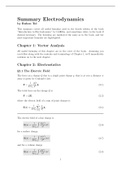Summary Electrodynamics
by Ruben Tol
This summary covers all useful formulas used in the fourth edition of the book
”Introduction to Electrodyamics” by Griffiths, and sometimes refers to the book if
deemed necessary. The formulas are numbered the same as in the book, and the
most important formulas are high-lighted.
Chapter 1: Vector Analysis
All useful formulas of this chapter are in the cover of the book. Assuming you
can follow along with the contents and terminology of Chapter 1, we’ll immediately
continue on to the next chapter.
Chapter 2: Electrostatics
§2.1 The Electric Field
The force on a charge Q due to a single point charge q, that is at rest a distance r
away is given by Coulomb’s law:
1 qQ
F=
4π�0 2r r̂r
. (2.1)
The total force on the charge Q is
F = QE, (2.3)
where the electric field of a sum of point charges is
n
1 X qi
E(r) ≡
r r̂r .
4π�0 i=1 2i
i (2.4)
The electric field of a line charge is
λ(r0 ) 0
Z
1
E(r) = dl ; (2.6)
4π�0 r 2
for a surface charge,
σ(r0 ) 0
Z
1
E(r) = da ; (2.7)
4π�0 2r
and for a volume charge
ρ(r0 ) 0
Z
1
E(r) = dτ . (2.8)
4π�0 2r
1
,§2.2 Divergence and Curl of Electrostatic Fields
For any closed surface, Gauss’s law gives us that
I
Qencl
E · da = , (2.13)
�0
where Qencl is the total charge enclosed within the surface.
Gauss’s law in differential form for any volume is given by
ρ
∇·E= . (2.14)
�0
Even though Gauss’s law is always true, it is not always useful. Symmetry is crucial
to the application of Gauss’s law. The three symmetries that work are:
1. Spherical symmetry: make your Gaussian surface a concentric sphere.
2. Cylindrical symmetry: make your Gaussian surface a coaxial cylinder.
3. Plane symmetry: use a Gaussian ”pillbox” that straddles the surface.
Calculating the curl of E yields that the integral around a closed path is zero, so:
I
E · dl = 0, (2.19)
and hence, applying Stokes’ theorem (Eq. 1.57 in the book),
∇ × E = 0. (2.20)
This is also the requirement for an electric field E to be conservative.
§2.3 Electric Potential
Eq. 2.19 tells us that the line integral of E from any point a to point b is the same
for all paths. Using this result, we can define a function for the electric potential:
Z r
V (r) ≡ − E · dl, (2.21)
O
where O is some standard reference point.
Since this holds true for any two points a and b, we find that
E = −∇V. (2.23)
Poisson’s equation is given by
ρ
∇2 V = − . (2.24)
�0
2
, To compute V when we know ρ, we use
ρ(r0 ) 0
Z
1
V (r) = dτ . (2.29)
4π�0 r
The reference point O is assumed to be at infinity. Only if the charge itself extends
to infinity, then integrate from a different arbitrary point of reference.
§2.4 Work and Energy in Electrostatics
The work W needed to bring n charges together is given by the general rule
n n
1 X X q i qj
W = . (2.40)
4π�0 i=1 j>1 ij r
Page 92 of the book has a worked-out explanation of this for two, three and finally
four charges.
§2.5 Conductors
In an insulator, each electron is on a short leash, attached to a particular atom. In
a metallic conductor, one or more electrons per atom are free to roam. An ideal
conductor would contain an unlimited supply of free charges. The basic electrostatic
properties of ideal conductors are as follows:
1. E = 0 inside a conductor (like a grounded Faraday cage).
2. ρ = 0 inside a conductor (following from Gauss’s law).
3. Any net charge resides on the surface (as surface charge σ).
4. A conductor is an equipotential (V (a) = V (b)).
5. E is perpendicular to the surface, just outside a conductor.
The energy of a continious charge distribution is
Z
�0
W = E 2 dτ. (2.45)
2
Capacitance is given by
Q
C≡ . (2.53)
V
The work needed to charge up a capacitor is
1
W = CV 2 . (2.55)
2
3






